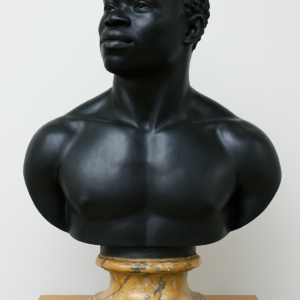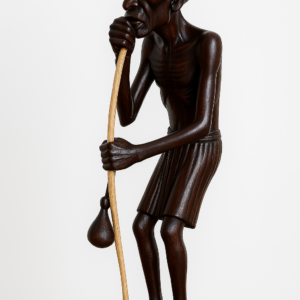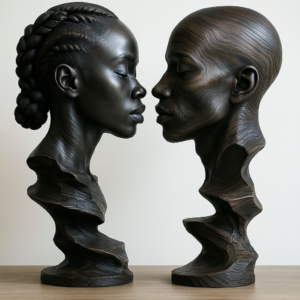Nguvu ya Milele (Swahili for “Eternal Strength”)
Nguvu ya Milele is a commanding work of contemporary Afrocentric sculpture, inspired by the majestic rhinoceros—a sacred and symbolic animal across many African traditions. The name translates from Swahili as “Eternal Strength,” capturing the essence of what this piece embodies: timeless resilience, rooted dignity, and unshakable presence.
Sculpted in a stylized, abstract form, this artwork reinterprets the natural might of the rhinoceros through a minimalist yet deeply expressive lens. With its sweeping, sky-bound horn and grounded, compact body, the sculpture radiates both motion and stillness—an emblem of balance between strength and grace. It is a visual narrative that honors Africa’s wildlife, artistic legacy, and ancestral connection to nature.
The sculpture stands tall at an estimated 30 inches in height (from base to horn tip), with a body length of approximately 16 inches and a width of around 6 inches. It weighs between 10 pounds, giving it a substantial but manageable presence perfect for pedestal or tabletop display. It is crafted from high-density cast resin, chosen for its durability and capacity to replicate fine details, then hand-finished with a bronze-like stippled surface that mimics traditional metalwork textures.
The surface is a story in itself. Thousands of tiny dot-like indentations cover the body, evoking hand-hammered techniques found in African bronze and iron traditions. This texture catches light subtly, enhancing the sculpture’s contours while providing a tactile experience. The long, curved horn—arguably the most dramatic feature—soars upward in a smooth arc, visually guiding the viewer’s eye from base to sky, grounding the sculpture in movement, ambition, and spirit.
Across many African cultures, the rhinoceros is seen not only as a powerful animal but as a spiritual guardian. Its horn is a symbol of protection and medicine in myth, its posture one of boundary and bravery. In this sculpture, the symbolism is amplified by the artistic decision to elongate the horn to exaggerated proportions—transforming it into a sacred gesture of upward strength and resilience over time.
The stance of the rhino is one of pride: legs firmly planted, body curved with tension, as if paused mid-stride. From this angle, Nguvu ya Milele suggests readiness—a protector not in attack but in watchful silence. Its eye, subtly carved and almond-shaped, gives the impression of awareness, depth, and ancestral wisdom.
What makes this piece especially powerful is its dual identity. It exists simultaneously as an animal and a totem. It feels ancient yet modern, decorative yet deeply meaningful. In African sculpture, this duality is a mark of excellence—art that beautifies while speaking of legacy, art that looks inward and outward.
This sculpture was designed with versatility in mind. It fits seamlessly into both modern and traditional interiors. In a home, it becomes a focal point—commanding but not overpowering. In a gallery, it holds space and invites interpretation. In a spiritual or contemplative space, it becomes a silent anchor for grounding energy and presence.
Each sculpture is carefully handcrafted and finished, meaning no two are identical. Slight variations in patina and texture ensure every collector receives a one-of-a-kind version. The piece is sealed with a matte protective finish that guards against wear, fading, or dust accumulation.
It arrives packaged in a custom foam-fitted box with reinforced corners, ensuring safe transport no matter where it travels. Whether you are an art collector, an interior designer, or someone seeking a culturally rooted, sculptural statement piece, Nguvu ya Milele offers more than visual appeal—it offers story, legacy, and presence.
Ultimately, this is not just a sculpture. It’s a declaration of what strength means. Not aggression, but rootedness. Not brute force, but purposeful stillness. It is an embodiment of what African wildlife and culture teach us: that true power is silent, timeless, and deeply connected to the earth we stand on.





Reviews
There are no reviews yet.